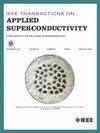High-Order Dual-Band High-Temperature Superconducting Bandpass Filter Using Asymmetric Input/Output (I/O) Feeding Technique
IF 1.7
3区 物理与天体物理
Q3 ENGINEERING, ELECTRICAL & ELECTRONIC
引用次数: 0
Abstract
In this article, a high-order dual-band high-temperature superconducting (HTS) bandpass filter (BPF) is proposed, integrating a novel dual-mode hairpin ring resonator (HRR) and an asymmetric input/output (I/O) feeding technique. The proposed HRR features two independently controllable resonant modes, providing enhanced design flexibility for precise frequency and bandwidth control. By leveraging the dual-mode HRRs and optimized coupling schemes, a miniaturized high-isolation sixth-order dual-band HTS BPF is designed. The two passbands are centered at 1.42 GHz with a 7.04% fractional bandwidth for deep space exploration and 1.9625 GHz with a 3.31% fractional bandwidth for 5G mobile communication. To further improve filter performance, an asymmetric I/O feeding technique is introduced, enabling independent control over transmission zeros (TZs). This approach results in a more compact design, greater flexibility, and eliminates the need for additional space. In addition, this technique allows independent tuning of the external quality factors for both passbands, providing greater design flexibility in optimizing filter performance. Four TZs are excited, i.e., two between the two bands, one in the lower stopband, and one in the upper stopband, improving the skirt selectivity and stopband performance of the HTS filter. The working mechanisms of TZs are analyzed in detail. Finally, the designed filter is fabricated on an MgO substrate with YBa2Cu3O7 (YBCO) thin films. The measured results agree well with the simulated ones, demonstrating maximum insertion losses of 0.25 and 0.21 dB in the two passbands, respectively.采用非对称输入/输出(I/O)馈电技术的高阶双频高温超导带通滤波器
本文提出了一种高阶双频高温超导(HTS)带通滤波器(BPF),该滤波器集成了一种新型双模发夹环谐振器(HRR)和非对称输入/输出(I/O)馈电技术。提出的HRR具有两种独立可控的谐振模式,为精确的频率和带宽控制提供了增强的设计灵活性。利用双模hrr和优化的耦合方案,设计了一种小型化的高隔离六阶双频HTS BPF。这两个频段以1.42 GHz为中心,深空探测带宽为7.04%,5G移动通信带宽为1.9625 GHz,带宽为3.31%。为了进一步提高滤波器性能,引入了非对称I/O馈电技术,实现了对传输零点(TZs)的独立控制。这种方法的结果是更紧凑的设计,更大的灵活性,并消除了对额外空间的需求。此外,该技术允许独立调整两个通带的外部质量因素,在优化滤波器性能方面提供更大的设计灵活性。在两个频带之间、下阻带和上阻带分别激发了4个TZs,提高了HTS滤波器的裙边选择性和阻带性能。详细分析了压电陶瓷的工作机理。最后,利用YBa2Cu3O7 (YBCO)薄膜在MgO衬底上制备了该滤波器。测量结果与模拟结果吻合良好,两个通带的最大插入损耗分别为0.25和0.21 dB。
本文章由计算机程序翻译,如有差异,请以英文原文为准。
求助全文
约1分钟内获得全文
求助全文
来源期刊

IEEE Transactions on Applied Superconductivity
工程技术-工程:电子与电气
CiteScore
3.50
自引率
33.30%
发文量
650
审稿时长
2.3 months
期刊介绍:
IEEE Transactions on Applied Superconductivity (TAS) contains articles on the applications of superconductivity and other relevant technology. Electronic applications include analog and digital circuits employing thin films and active devices such as Josephson junctions. Large scale applications include magnets for power applications such as motors and generators, for magnetic resonance, for accelerators, and cable applications such as power transmission.
 求助内容:
求助内容: 应助结果提醒方式:
应助结果提醒方式:


